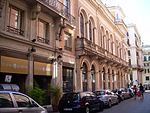Istituto Nazionale per la Grafica

The Istituto Nazionale per la Grafica (National Institute for the Graphic Design) is an Italian institute having the aim of preserving, protecting and promote a heritage of works providing documentary evidence of all types of graphic design: prints, drawings, photographs. The institute is located in Rome and is managed by the Directorate-General for Contemporary Landscape, Arts and Architecture of the Italian Ministry of Cultural Heritage and Activities. The institute is housed in the monumental complex of Trevi Fountain, consisting of Palazzo Poli and neighbouring Palazzo della Calcografia, built in 1837 by architect Giuseppe Valadier as headquarters of the Chamber Intaglio, directed by Valadier himself for decades. The historic Palazzo Poli was purchased in 1978 by the Italian State, with the very purpose of unifying the National Intaglio and the National Cabinet of Prints, which in 1975 were merged into the present institute.
Excerpt from the Wikipedia article Istituto Nazionale per la Grafica (License: CC BY-SA 3.0, Authors, Images).Istituto Nazionale per la Grafica
Via della Stamperia, Rome Municipio Roma I
Geographical coordinates (GPS) Address Nearby Places Show on map
Geographical coordinates (GPS)
| Latitude | Longitude |
|---|---|
| N 41.9011 ° | E 12.4831 ° |
Address
Palazzo Poli
Via della Stamperia
00187 Rome, Municipio Roma I
Lazio, Italy
Open on Google Maps










